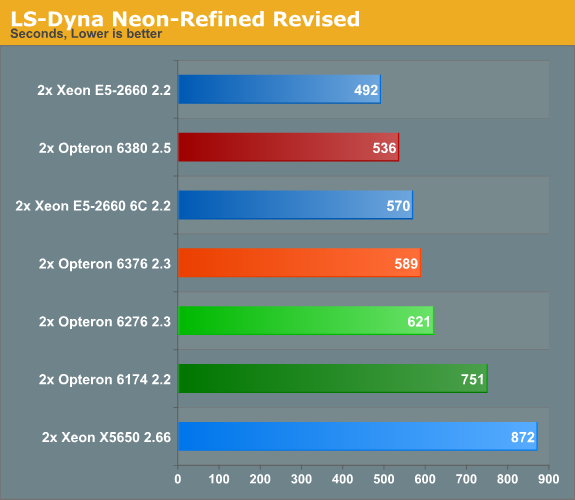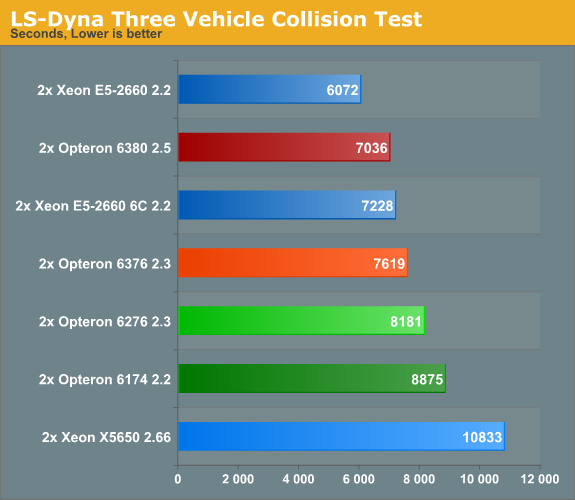The new Opteron 6300: Finally Tested!
by Johan De Gelas on February 20, 2013 12:03 AM ESTLS-DYNA
LS-DYNA is a "general purpose structural and fluid analysis simulation software package capable of simulating complex real world problems", developed by the Livermore Software Technology Corporation (LSTC). It is used by the automobile, aerospace, construction, military, manufacturing and bioengineering industries. Even simple simulations take hours to complete, so even a small performance increase results in tangible savings. Add to this the fact that many of our readers have been asking that we perform some benchmarking with HPC workloads and we have reasons enough to include our own LS-DYNA benchmarking.
These numbers are not directly comparable with AMD's and Intel's benchmarks as we did not perform any special tuning besides using the message passing interface (MPI) version of LS-DYNA (ls971_mpp_hpmpi) to run the LS-DYNA solver to get maximum scalability. This is the HP-MPI version of LS-DYNA 9.71. Our first test is a refined and revised Neon crash test simulation.

The second test is the "Three Vehicle Collision Test" simulation, which runs a lot longer.

Both test paint a similar picture. The new Opteron 6376 is 5% to 7% faster than the Opteron 6276. The best AMD Opteron (6380) is about 16% faster than the previous one (6276). Not bad at all, but HPC buyers are typically categorized as either going after top performance or searching for the best performance per dollar.
The first category will go after the best Xeon E5s like the Xeon E5-2690 or the 2670 (2.6GHz, 115W) if the former's power usage is too high to fit in the dense server chassis. The second category can get 10% higher performance (E5-2660 vs 6380) for a few hundred dollars more. It is close, but it is probably not convincing enough to go for AMD. Most professional buyers need a bigger incentive before they will choose the underdog over the market leader.
HPC people are less concerned about energy consumption, but even HPC data centers run into cooling and energy supply limitations. Next stop, high performance energy consumption measurements.










55 Comments
View All Comments
coder543 - Wednesday, February 20, 2013 - link
99%? I love your highly scientific numbers. and yes, of course only Intel can design a perfect processor. I'm glad you were here to let everyone know.To quote Abraham Lincoln, (no, not really) "All of our servers run Intel. Everything AMD makes is no better than British tea."
Tams80 - Wednesday, February 20, 2013 - link
How much are Intel paying you? XDSeriously though; you've gone through the entire comments* posting walls of texts that add little to the discussion. Not only that, but your posts are a little offensive.
*I realise I'm being hypocritical here.
JKflipflop98 - Wednesday, February 20, 2013 - link
Well, Intel does pay me and I'll be the first to say these chips are lookin pretty good in comparison with their previous generation counterparts. Good value for the money for sure.As Anand says, however, HPC users are usually after the "extreme" ends of the scale. They're either after max performance or max performance to fit into a certain power/heat envelope. In either case, we win.
Tams80 - Wednesday, February 20, 2013 - link
I'm sure you know what I mean. It wasn't exactly high brow humour.They certainly do look good, especially for a company that has already invested in AMD chips. Intel may well be better in both use cases, but at least AMD are providing competent competition.
tech6 - Wednesday, February 20, 2013 - link
The AMD 6x000 series has always looked nearly competitive on paper but is nowhere near Intel performance and efficiency. We have 3 data centers and one is running a mix of 6100 and 6200 Opterons while the others a re older Xeon 7300s and new E5 Xeons. In terms of single threaded and total performance of the 6x00 series cannot keep up with even old 7300 Xeons and can't touch the E5s. What AMD needs is a 30-40% boost in real world performance before they could be considered competitive. AMD also needs better relations with VMWare to optimize memory management on that platform.The price difference won't help them as the cost for a data center host is mostly software and can be $15 vCloud and $10K hardware. That reduces the cost advantage to 5% but delivers worse performance and uses more power.
Most data centers are looking to get the most from their VMWare investments while reducing power consumption and these AMDs do neither.
duploxxx - Wednesday, February 20, 2013 - link
interesting information, but hard to catch if you don't add some figures and real data.Firsts of all the 7300 series had huge disadvantages with there FSB, so mentioning that these are way faster then the 6100-6200 opteron series is debatable. I 100% tend to disagree and we had severe Vmware performance issues on these machines on our highend applications.
i'll just used anandtech as a refference:
http://www.anandtech.com/show/2851/8
http://www.it.anandtech.com/show/2978/amd-s-12-cor...
even the 7400 series are a dog against opteron 8000 series and they are way older and slower against the 6000 series.
for the E5 you have a point there, often the E5 series show a higher responsive platform, but once you load real life applications within hypervisor and they are starting to hit those HT cores we have seen several degraded performance within our datacenters, this is not really resulted into the anandtech VAPU's scores due to some sw within the benchmark that provides some code optimised results for the intels (the web servers) hence the higher score.
The 6200 series did showe some response disadvantages but many things have to do with configuration of bios and power profiles in both server and hypervisor. might want to blame the setup rather then the servers. so for 6200 series we actually bought a 10% higher clock speed version to cover that, but reduced that again now with 6300 series.
silverblue - Wednesday, February 20, 2013 - link
I'm going to go trawl the internet (note I said trawl, not troll - very important to bear in mind) for articles on FX CPUs resulting in PCs dying... nope, no matches. Funny, huh?I've also run a search concerning AMD CPUs producing incorrect results and crashing; any such occurrences would be the results of design bugs which, I must point out, are not limited to AMD. Nehalem had a bug causing spurious interrupts that locks up the hypervisor on Windows Server 2008 R2, for example. Core 2 had a huge list of bugs.
Shadowmaster625 - Wednesday, February 20, 2013 - link
It is hard to disagree with the statement, knowing how overpaid US IT professionals are. But I just want to point out that this mentality is one of the reasons IT is being outsourced at a furious rate. Keep that in mind before you go blaming someone else for US jobs being lost.This meager cost savings may not matter here, but what about some company in Asia? They might actually bite on a few hundred dollar savings, especially if they are ordering quantities in the hundreds. In that case, $300 becomes $30,000. Which might be more than they spend on the people who deploy those servers.
ExarKun333 - Wednesday, February 20, 2013 - link
Outsourced work isn't much cheaper these days and the workers are of much less quality, on a whole.sherlockwing - Wednesday, February 20, 2013 - link
Except in Asia( especially developing countries) the cost of electricity is a lot higher due to rapidly expanding industry,population & lacking power plants.